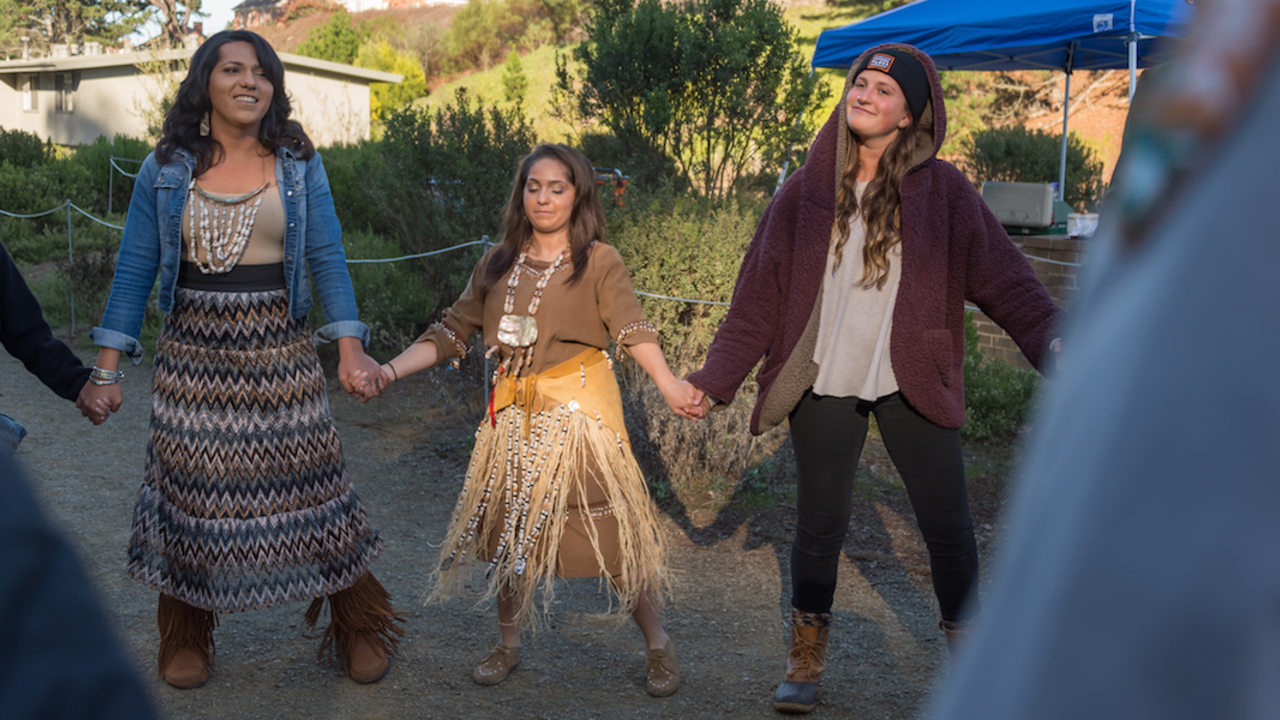Remembering the Ohlone, then and now

Alison Taggart-Barone/Parks Conservancy
By: Laurasia Holzman Smith
San Mateo Park Stewardship Intern
When I learned of a new exhibit at the Pacifica History Museum on the Ohlone people, I was eager to stop by for a visit. The native Ohlone people were the first to inhabit and actively manage the resources on the land within our park sites in San Mateo County. Not only did the exhibit educate me in greater detail on the way of life of the Ohlone in Pacifica, it allowed me to reflect on how we take care of these ancestral lands. It left me thinking about my impact as someone who grew up in San Mateo, someone who contributes to restoration efforts in our open spaces, but also as someone who has European ancestors responsible for the colonization of this country.
The exhibit was full of interesting details about how different tribes of native people respected the land and used it in a way which ensured plentiful resources for future generations. I was in awe learning about how they used different plants: tule reeds to build various living structures, soaproot for food, insect repellent, and brushes, as well as creek willow branches for pain relief. If you’re interested in reading more about the Ohlone social structures, practices, traditions, and stewardship, I strongly encourage you to visit the museum because it’s full of informative material.
In 1769, the first Spanish explorers came to Pacifica, on what we know as the Portola expedition, and life as the Ohlone knew it forever changed. The intentions of the explorers were to colonize Alta California and convert the native people to Christianity and Spanish culture. In working towards this goal, the Ohlone were stripped of their land, culture, and people. Spanish colonizers displaced native people by baptizing them and moving them to live a life within the mission, while they started to use their land for practices such as cattle grazing. While the museum exhibit acknowledges this history, it is important, as a visitor, to reflect on the wrongdoings the indigenous populations of that time faced, and recognize how challenges persist today. My hope is that this article encourages contemplation and a future conversation.
The Ohlone and their rightful land continue to remain unrecognized federally and by the state of California, despite decades of continual petitioning and advocacy for their people. Recognition has proven difficult due to various barriers including the strong desire for housing along the Coast, including the land from which the Ohlone were displaced. As someone who grew up in San Mateo, I have been made to feel that it and the greater Bay Area are my home. However, I think it’s important to acknowledge that I am not indigenous to this land, so I want the way I interact with it to respect and recognize the people who were here first.
My hope is for a shift towards greater cooperation and inclusion between the parks and the native people. Part of our mission at the Golden Gate Parks Conservancy is to create parks for all and forever. This must include the indigenous people who know these parks to be their home, their place for cultural practices, and their market.
Within the Golden Gate National Recreation Area, the National Park Service and Golden Gate National Parks Conservancy are involved in many efforts to build and foster a relationship with the native Ohlone people. For several years, there was a gathering at Rob Hill Campground organized and hosted by the Costanoan Rumsen Carmel Tribe.
The National Park Service also hosts two Indigenous Peoples Sunrise Ceremonies every year on Alcatraz, at which they commemorate the 1969-71 occupation of Alcatraz by the “Indians of All Tribes,” as well as the survival of Native American peoples following the settlement of Europeans in the Western Hemisphere, which led to enormous economic and cultural losses among the indigenous people due to disease, warfare, and social disruption. This year is the 50th anniversary of the occupation on Alcatraz and there will be a variety of events and conversations, open to the public, focused on the injustices that native people have experienced and the challenges they continue to face.
Perhaps there is even more to learn from the progress happening in other areas, such as down south with the Amah Mutsun tribe and the Midpeninsula Regional Open Space, where a partnership has been created between the groups. The partnership fosters respect and understanding of maintaining and nourishing the cultural practices of the native people, while ensuring the land is accessible to everyone. A cultural conservation easement was approved for over 36 acres atop Mount Umunhum, granting the Amah Mutsun Tribal Band permanent rights to help steward the mountaintop for natural resource conservation, cultural relearning, and public education in partnership with Midpen. Mount Umunhum is a sacred site to the Amah Mutsun people and is central to their creation story. In exchange for the benefits to the tribe under the easement, the tribe provides volunteer educational, cultural, and natural resource advising services to the district and public.
One of the ways organizations can do more to be respectful and honor the land they are using—hosting events, programs, or big gatherings—is by creating space and inviting indigenous people of that area to speak and share a land acknowledgement.
I feel incredibly grateful to be a part of the restoration efforts throughout our San Mateo parks. I want to continually reflect on what it means for me, as a non-indigenous person, to be stewarding this land and I hope to have conversations with native people, locals, and coworkers about their perspectives, in order to bring these thoughts to the surface within our parks.
*The Pacifica History Museum is open Tuesdays, Thursdays, and Saturdays from 1-4 p.m.